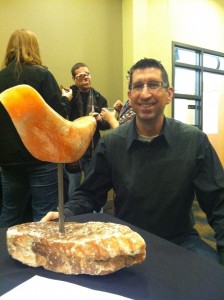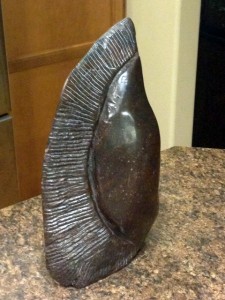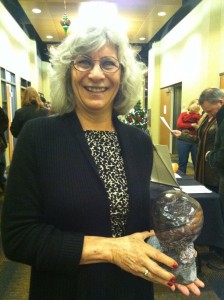The following artist statements are by those who gave permission for us to publish them. Congratulations, students!
John L. Harper
“Fish Out of Water”
Type of Stone: Alabaster
Why I took this class
I wanted to explore the connection between Leadership and Art. I was unsure that there was an obvious connection, but I did hear about the experience of this class from other former students. Secondly, I wanted to see if I could be creative with my hands. What could be the result of a skill that is taught and a space to create?
My Expectations and the Outcome
I expected to have something to show for my efforts in carving as well as learning a skill that previously I had not obtained. The outcome was a pleasant surprise I was being changed as my carving was taking shape. I found as I was filing or chipping away at the stone that my pre-conceived notions were being chipped away as well. I was carving the stone, but the surprising part was that I was being shaped by the process. I am my stone. I have some parts like my stone that are further along in the process but some areas that have not been fashioned through the crucible of leadership. The field of creativity and leadership intersected for me when I realized that my strengths and weaknesses as a leader were being displayed in the way I carved the stone. I found the connection between leadership and art as I realized that every time I came to class and entered the field of carving stone that the potential for the finished product was always there. What I needed to do was to enter the field of carving the stone as I perceived the potential of the pattern that was set before me. As a leader I must discern the pattern that exists in a given organization in which I serve. Once I have discerned the pattern I can assume what the outcome will be. In other words acorns only produce oak trees.
Conclusion
This experience has impacted me as a leader in letting go of such concepts as absolute perfection and ultimate completion. Perfectionism hinders leadership as the goal of perfection is rarely attained. Perfectionism hinders me from attempting anything that is a challenge to me because of fear that it will not be good enough. How will the soul ever take wings and fly if there is always a voice of criticism that hinders creativity? It has been said that perfectionism is a murdering part of the soul. My leadership and work with others is not perfect, but progressing and my process of being molded into a leader is far from complete. My sculpture is finished on one side and on the other side it is unfinished. This is symbolic of my journey as a leader, some areas are polished and some areas need a bit of work.
Mike Cox
Blended Wholeness
Pyrophyllite: From the Greek for fire (pyro) and leaf (phyllos)
Unsuccessful at enrolling in a necessary core class (Leadership Theory) this semester led me to this elective course offering. I thank God that I was unable to enroll in the originally class as this class offered so much more than I could ever have fathomed. This “elective” should be a “core” requirement.
Initially, I did not know what to expect and that reality was, at once, liberating and nerve racking. As we evolved (my stone and I), I entered into periods of deep and intense reflection upon my own life and work experiences over the last nine months. This intentionally reflective time invited me into a period of self-introspection, challenge, growth, and suffering met with love that has given me profound insights into my own soul as a husband, father, son, brother, friend, and leader. What is beautiful is that these insights are renewed each time I gaze into my stone.
Much like life, the evolution of this piece had its ups and downs. For a number of weeks, I struggled trying to think my stone into a carving. Not until I let go of my preconceived ideas and listened to the stone’s voice did I begin to experience a connection that gave me the ability to see the stone’s identity and meaning there for me to carve and release it. What emanated from this process is best summed up by the stone’s two edges.
The stone represents the integration of two realities (edges) within the field of leadership. The sharp edge represents suffering and the seamless, rounded edge, represents healing and compassion. Leaders often make decisions that have a significant impact on people’s lives and can easily lead to suffering. How leaders blend the two edges within themselves and the organizations they lead is the question that falls within the field of creativity. There is no template for responding to suffering, save for authentic compassion and love. Compassion’s meaning is “to suffer with.” How do we suffer with those we lead? How do we understand our own suffering as leaders? These are questions best understood as part of our own creative journey of leadership. No easy or simple answers, but an invitation to explore what is within each of us.
I am thankful that my journey continues within these two fields. Seeing one’s leadership journey as creative process rather than career development gives me new eyes and a sense of gratitude for all those throughout my life that have shaped me and continue to shape me into the leader that I am continually, and creatively, becoming. My only hope is that I can serve others in a similar fashion and share these learnings with whomever would like to listen.
Sylvia Behrend
Churinga
Pyrophylite
an object of wood or stone that is considered sacred by various aboriginal tribes of Central Australia and that is often elliptical in shape, bears incised designs, is believed to represent either the spiritual double of a living native or the embodiment of the spirit of a totemic ancestor, and is generally regarded as secret; sometimes: the quality of sacredness
I started carving while on sabbatical from my former parish in Salt Lake City. The experience of carving in community revealed the power of transformation, both personal and collective that can occur when people engage in the creative process. The field of creativity, that which exists in potentia waiting to be incarnated in matter, holds a multitude of possibilities. A sculpture is the concrete result of the engagement between the particular artist and the particular stone at a particular time.
There are certain characteristics inherent in the field of creativity: the artist has to allow the non-rational aspect of existence to emerge, to see, and feel with intuition, to know without knowing, to trust without proof. It requires that the ego step aside and relinquish the illusion that it is in control; the voices of self-criticism, perfectionism, and certainty must be quieted. Only then can that which is possible, new and innovative, emerge.
This speaks to the field of leadership in a powerful and direct way. The field of leadership will call someone to exercise power and authority in the service of and in relationship with something greater than itself. That requires a person who is able to see what is possible, in people and situations. It can call one who can do what must be done with vision, insight, and intuition, who has the experience of allowing the ego to disappear so that something new may appear. It is a dance of knowing when to step and when to follow, when to be forceful and when to be gentle. One cannot be inauthentic in the dance because the stone will respond in kind.



